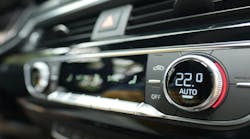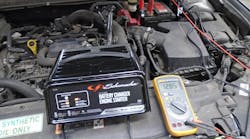Content brought to you by PTEN. To subscribe, click here.
When it comes to providing proper service for your customer's tire and wheel needs, you'll need to invest in the right equipment. You are going to need a tire machine, a wheel balancer, wheel weights, TPMS sensors, and a triggering device.
Unfortunately, you're not going to be able to service all makes and models with just one tire machine (unless you spend a large sum of money on equipment). When deciding on the equipment to purchase, you need to look at the types of vehicles that make up your fleet. For example, a high-end piece of equipment may not be needed for luxury brand vehicles and aftermarket rims.
For most of our fleet, we can service with just our rim clamp, but as part of our business model, we do quite a bit of work for local body shops where our Hunter unit comes in handy.
Tire/wheel equipment
When I purchased the Atlas TC755 Tilt-Back Rim-Clamp Tire Changer (Figure 1), I also purchased the two add-on accessory arms. The tire machine has been a great purchase for us, especially with the add-ons. The arms have made mounting low-profile tires so much easier. The tire machine we had prior to the Atlas did not have provisions for adding accessory arms which was a major reason for upgrading. Prior to the new machine, I used to dread handling low-profile tires. We do about 80 percent of all our tires on that machine and have been very pleased with the ROI. We prefer to use the rim clamp as it does tend to be quicker than the Hunter unit. It’s also more forgiving to work with. My technicians take to the machine quicker as there are fewer features than our other machine.
We purchased the Hunter TCA28 Tire Changer (Figure 2) used approximately a year ago. We needed a better alternative for the higher-end rims than just our rim clamp. The unit is a bit older, but it’s in good shape, which is typically the case for Hunter equipment. It can be a little challenging to get used to, but as with any Hunter machines, they have refined it in the subsequent generations. General maintenance, such as lubricating all the moving points and making sure the air dryer is empty, has been key to the longevity of this machine.
Our wheel balancer of choice is the Hunter GSP9700 (Figure 3). This was one of my first purchases when I opened the shop. It has been a great piece of equipment over the years. We have found many bent wheels with the Road Force Variation balancing. It’s always comforting to know that you’re able to diagnose a bent rim on the spot when servicing a vehicle. I much prefer to be able to give a customer a heads-up when they pick up the vehicle or even contact them throughout the course of the repair to keep them informed of anything out of the ordinary. It’s also a great machine for luxury brands for finding potential vibration concerns. You can quickly eliminate whether it’s a tire or rim issue with confidence.
Additional parts and tools
It always amazes me all the ancillary items you need for complete tire service. For example, you'll need:
- Valve stems
- TPMS sensors
- TPMS service kits
- Wheel weights
- Tire lube
- Tire repair supplies
It’s funny that I often think of tire service as "simple," but there’s really quite a bit to it. From the evolution of plugging tires to replacing them with patch plugs and the number of different valve stem designs to the selection of wheel weights, there's a lot more to it than first meets the eye.
Because there are so many wheel weights, we chose a wheel weight assortment from Napa that the company comes out to stock at our shop (Figure 4). On this monthly sales call, they also check our tire repair supplies to make sure that we don’t run out.
One of my frustrations for years has been TPMS systems. There wasn’t one company that could do all manufacturers. These were simple systems that were forced on the industry in a relatively short period of time. Everyone, including manufacturers, had their own way of doing it and as a result, the industry was a mess.
One of the big things that I respect Autel for is their complete solution to TPMS. As with any aftermarket scanner, I am sure there are holes, but I have yet to run into any of them. We use the Autel MaxiSYS MS906TS (Figure 5) which has a great report feature that can be printed out to show the customers ahead of time to alert them to any issues. Autel also makes one sensor for all vehicles. I can now stock just one part with my scanner, and I have 100 percent coverage. The valve stems are changeable with the click of a button. Both aluminum and rubber valve stems are available. Don’t forget to check the sensors on the vehicle before you begin to service the tires. It’s always better to identify a problem with a sensor ahead of time.
Wheel alignment
Our next step is wheel alignment. I am lucky that I am in Pennsylvania, and we still have a safety inspection program. My technicians are used to inspecting vehicle suspension systems. They are trained to do that before going on the alignment rack and catching problems ahead of time. If you have a chassis component that you just can’t quite pinpoint, try doing a “dry steer test.” By having the vehicle on the ground and having another technician rock the steering wheel back and forth, you are more likely to find a loose component on the ground than while hanging it in the air. We use a Hunter HawkEye Elite aligner for our alignments. One of the great features of the machine is the tire clamp targets which have taken out all anxiety of potentially damaging an expensive rim.
Let’s not forget the white elephant in the room, ADAS. Part of proper wheel and tire services these days should not only include a four-wheel alignment, but also any required ADAS calibrations. Where can you find out which calibrations the vehicle needs? Well, more and more we are seeing the Hunter alignment machine alert us that the vehicle is going to need a calibration before the alignment is started.
We also have a subscription to Mitchell’s ProDemand and have found ALLDATA to have a great area to identify ADAS systems on vehicles and when they will need calibration.
As you can see from Figure 6, we have an Autel IA900WA Wheel Alignment and ADAS System next to the aligner. We do so many alignments and ADAS calibrations that we really need both machines. By not performing the required calibrations, you are setting yourself up for potential legal problems. I have had several conversations with my insurance agent on this topic and we cannot get a good answer as to how it would be treated. Not doing a calibration is no different than not tightening caliper bolts on a brake job.
Remember if you are in the tire business, you are in the ADAS business.








